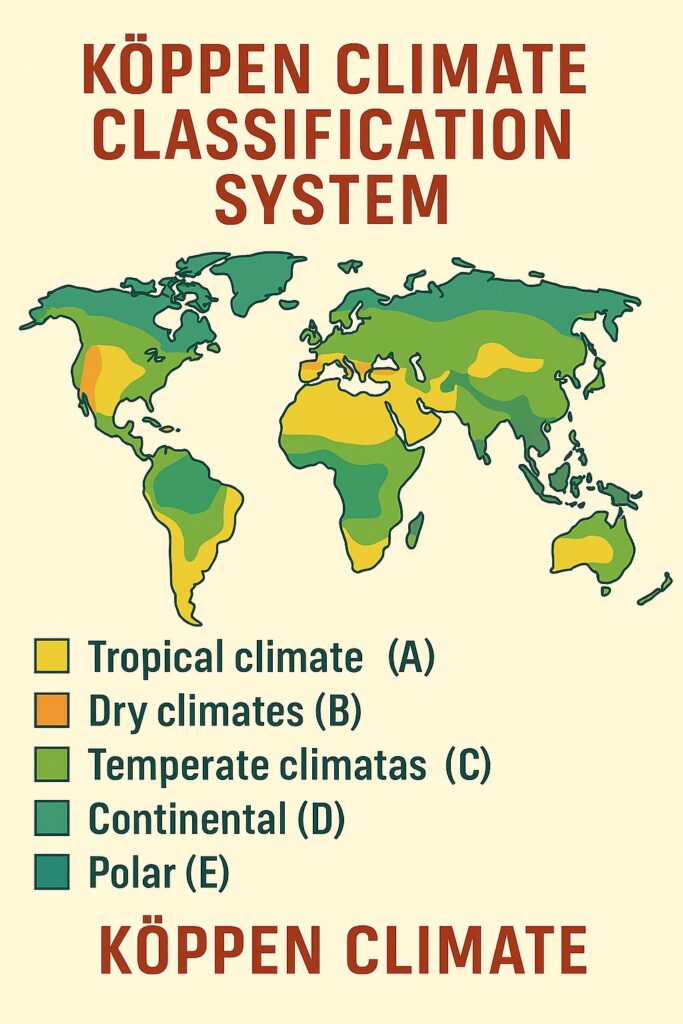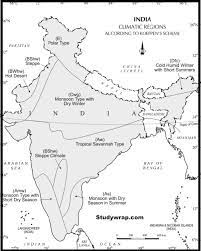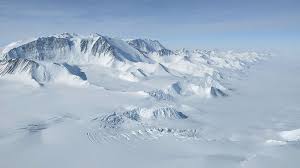The Koppen Climate Classification System is a widely used system for classifying the world’s climates based on their temperature and precipitation patterns. It was first developed by German botanist and climatologist Wladimir Koppen in the early 20th century and has since undergone several revisions.

The Koppen Climate Classification System divides the world’s climates into five major groups, based on the average monthly temperature and precipitation of a location. These groups are further subdivided into smaller categories based on additional criteria, such as the presence or absence of a dry season or the amount of annual rainfall.

Table of Contents
Five Primary Koppen Climate Classification
- Tropical Climates (A): These climates are characterized by high temperatures and high levels of precipitation throughout the year. They are typically found near the equator, where the sun’s rays are most direct and intense.

Tropical Climate - Dry Climates (B): These climates are characterized by low levels of precipitation and high temperatures, and they are often found in regions with a subtropical or desert-like climate. Here, the evaporation exceeds the rainfall and the region is a water deficit.

Dry Climate - Temperate Climates (C): These climates are characterized by moderate temperatures and precipitation levels, and they are found in many regions with moderate latitude and moderate oceanic influence.

Temperate Climates - Continental Climates (D): These climates are characterized by extreme temperatures and highly variable precipitation levels, and they are typically found in regions with a large landmass and a moderate latitude.

Cold Forest Climate - Cold Climates (E): These climates are characterized by low temperatures and low levels of precipitation, and they are typically found in regions with a high latitude and high elevation.

Polar Climate
Sub-classification of Koppen Climate
m: The letter “m” is used to denote climates that have a monsoon season. Monsoons are seasonal winds that bring a shift in the direction of prevailing winds, causing wetter conditions during certain parts of the year. Climates with a monsoon season are typically found in tropical and subtropical regions, where they can cause heavy rainfall and flooding.
f: The letter “f” is used to denote climates that have sufficient rainfall throughout the year (No Rain Free Month) to support the growth of a rainforest. These are known as rainforest climates and are typically found in equatorial regions where there is high rainfall and abundant vegetation.
w: The letter “w” in the Koppen Climate Classification System refers to a dry winter season. This letter is typically added as a suffix to the letters that represent the climate group to which the zone belongs.
S: The letter “S” in the Koppen Climate Classification System is used to denote a dry summer season. This letter is typically added as a suffix to the letters that represent the climate group to which the zone belongs.
Af Climate
The Af climate in the Koppen classification is a type of tropical rainforest climate. It is typically found within 10 degrees of the equator, in regions where temperatures remain warm to hot throughout the year and rainfall is abundant. The Af climate is characterized by average temperatures of 18 °C or higher in every month of the year, and annual rainfall totals of at least 60 mm per month.
Some examples of areas with an Af climate include the Amazon rainforest in South America, the Congo Basin in Africa, and parts of Southeast Asia. The Af climate is often referred to as a “true” rainforest climate because of the consistently high levels of rainfall throughout the year.
Aw Climate
The Aw climate type, also known as the tropical savanna climate, is a climate classification under the Koppen system. It is typically found in areas near the equator with a distinct wet and dry season.
In the Aw climate, the average temperature of the coldest month is greater than 18°C and the average temperature of the warmest month is greater than 22°C (71.6°F). The annual precipitation is typically between 1000-2000 mm (39-79 inches) with a distinct dry season in winter lasting 5-7 months.
This climate type is characterized by grassy plains with scattered trees and shrubs and is home to many large herbivores such as zebras, giraffes, and elephants. The dry season can be harsh and vegetation can die back, but the rainy season brings new growth and replenishes water sources.

Am Climate
The Am climate, also known as the tropical monsoon climate, is a climate classification under the Koppen system. It is typically found in areas near the equator with a distinct wet and dry season, similar to the Aw climate.
In the Am climate, the average temperature of the coldest month is greater than 18°C (64.4°F) and the average temperature of the warmest month is greater than 22°C (71.6°F). The annual precipitation is typically between 1000-2000 mm (39-79 inches), with a distinct wet season lasting at least 7 months and a dry season lasting less than 5 months.
This climate type is characterized by heavy rainfall and high humidity during the wet season, often leading to flooding and landslides. The dry season can be hot and humid, with water sources becoming scarce. This climate type is often found in Southeast Asia, parts of Africa, and northern South America.
As Climate
Here the summer is dry and the region is located in the tropical region. It is rarely found.
In addition to the above classification scheme, Koppen selected certain letters and symbols specifically for the sub-categorization of the tropical region.
s: Summer Dry
i: The difference between the coldest and the warmest month is less than 5 degrees C.
g: The hottest season preceding precipitation.
w’: Maximum Precipitation in winter.
w”: Two Seasons of Maximum Precipitation and two dry seasons.
BWh Climate
The BWh climate, also known as the hot desert climate, is a climate classification under the Koppen system. It is characterized by high temperatures and low precipitation, with most areas receiving less than 250mm (10 inches) of rainfall per year.

In the BWh climate, the average temperature of the warmest month is greater than 22°C (71.6°F) and the annual precipitation is typically less than 200mm (7.9 inches). The temperature range in this climate type can be extreme, with hot temperatures during the day and cold temperatures at night.
This climate type is found in the subtropical and tropical regions of the world, including parts of North Africa, the Middle East, and the southwestern United States. The lack of precipitation in these areas leads to a scarcity of vegetation, and the landscape is often dominated by barren deserts and rocky outcrops.
BSh Climate
The BSh climate, also known as the hot semi-arid climate, is a climate classification under the Koppen system. It is characterized by high temperatures and low to moderate rainfall, with most areas receiving between 250-500mm (10-20 inches) of rainfall per year.
In the BSh climate, the average temperature of the warmest month is greater than 22°C (71.6°F), and the annual precipitation is typically less than the potential evapotranspiration. The temperature range in this climate type can be large, with hot summers and cool to mild winters.
This climate type is found in the subtropical and tropical regions of the world, including parts of Africa, Asia, Australia, and the Americas. The vegetation in these areas is often characterized by drought-resistant shrubs and grasses, with some scattered trees in areas where water is more readily available.
The BSh climate is often associated with dry and arid landscapes and is sometimes referred to as a desert climate. However, unlike true desert climates (such as the BWh climate), the BSh climate receives some rainfall throughout the year, albeit in low amounts.
BWk Climate
The BWk climate, also known as the cold desert climate, is a climate classification under the Koppen system. It is characterized by low precipitation and large temperature ranges, with hot summers and cold winters.
In the BWk climate, the average temperature of the warmest month is greater than 22°C (71.6°F), while the average temperature of the coldest month is below 0°C (32°F). The annual precipitation is typically less than 250mm (10 inches) and is often in the form of snow.
This climate type is found in the mid-latitude deserts of the world, including parts of North America, Asia, and Europe. The vegetation in these areas is often sparse, consisting of drought-resistant plants such as cacti and succulents.
The BWk climate is often associated with arid and barren landscapes and is characterized by extreme temperature fluctuations between day and night, as well as between seasons. During the day, temperatures can be very hot, but they can drop dramatically at night due to the lack of moisture in the air.
BSk Climate
The BSk climate, also known as the cold steppe climate, is a climate classification under the Koppen system. It is characterized by low precipitation and large temperature ranges, with hot summers and cold winters.
In the BSk climate, the average temperature of the warmest month is greater than 22°C (71.6°F), while the average temperature of the coldest month is below 0°C (32°F). The annual precipitation is typically between 250-500mm (10-20 inches), with most of the precipitation occurring in the form of rain.
This climate type is found in the mid-latitude steppes of the world, including parts of North America, Asia, and Europe. The vegetation in these areas is often characterized by grasslands, with some scattered trees and shrubs in areas where water is more readily available.
The BSk climate is often associated with dry and arid landscapes, and is similar to the nearby BWk climate, except that it receives slightly more precipitation. This climate type is characterized by extreme temperature fluctuations between day and night, as well as between seasons. During the day, temperatures can be very hot, but they can drop dramatically at night due to the lack of moisture in the air.
Terms Used by Koppen for Sub-classification of B-Type Climate
k: Mean Annual Temperature below 18 degrees Centigrade.
h: Mean Annual Temperature above 18 degrees Centigrade.
a: Summer is dry.
w: Winter is dry.
n: Minimum Fog
Cf Climate
The Cf climate, also known as the humid subtropical climate, is a climate classification under the Koppen system. It is characterized by hot and humid summers, mild winters, and ample precipitation throughout the year.
In the Cf climate, the average temperature of the warmest month is greater than 22°C (71.6°F), while the average temperature of the coldest month is above -3°C (26.6°F). The annual precipitation is typically between 1,000-1,500mm (39-59 inches), with rainfall occurring throughout the year.
This climate type is found in the subtropical regions of the world, including parts of eastern and southeastern Asia, the southeastern United States, and eastern Australia. The vegetation in these areas is often characterized by lush forests and grasslands, with a wide variety of plant and animal life.
The Cf climate is often associated with hot and humid summers, which can lead to thunderstorms and occasional tropical cyclones. The winters in this climate type are generally mild, with occasional cold snaps and frost. The ample rainfall in this climate type supports a wide range of agricultural activities, including the cultivation of crops such as rice, sugarcane, and tea.
Cw Climate
The Cw climate, also known as the warm temperate climate with dry winters, is a climate classification under the Koppen system. It is characterized by mild to warm summers, cool to cold winters, and low to moderate precipitation throughout the year.
In the Cw climate, the average temperature of the warmest month is greater than 10°C (50°F), while the average temperature of the coldest month is below 18°C (64.4°F). The annual precipitation is typically between 500-1,000mm (20-39 inches), with most of the precipitation occurring in the summer months.
This climate type is found in the mid-latitude regions of the world, including parts of North America, Europe, and Asia. The vegetation in these areas is often characterized by deciduous forests and grasslands, with a variety of plant and animal life.
The Cw climate is often associated with dry and sunny winters, which can lead to drought conditions in some areas. The summers in this climate type are generally warm and pleasant, with occasional thunderstorms and rain. The moderate precipitation and mild temperatures make this climate type suitable for a variety of agricultural activities, including the cultivation of grains, fruits, and vegetables.
Ca Climate
The Ca climate, also known as the hot-summer Mediterranean climate, is a climate classification under the Koppen system. It is characterized by hot, dry summers and mild, wet winters.
In the Ca climate, the average temperature of the warmest month is greater than 22°C (71.6°F), while the average temperature of the coldest month is above 0°C (32°F). The annual precipitation is typically between 500-1,000mm (20-39 inches), with most of the precipitation occurring in the winter months.
This climate type is found in the Mediterranean regions of the world, including parts of Europe, North Africa, and California. The vegetation in these areas is often characterized by scrubland, evergreen trees, and grasses.
The Ca climate is often associated with hot and dry summers, which can lead to wildfires and drought conditions. The winters in this climate type are generally mild, with occasional rain and snow. The moderate precipitation and mild temperatures make this climate type suitable for a variety of agricultural activities, including the cultivation of citrus fruits, grapes, and olives.
Df Climate
The Df climate, also known as the humid continental climate with hot summers, is characterized by warm to hot summers, cold winters, and moderate precipitation throughout the year. The average temperature of the warmest month is greater than 10°C (50°F), while the average temperature of the coldest month is below -3°C (26.6°F). The annual precipitation is typically between 500-1,000mm (20-39 inches).
Dw Climate
The Dw climate, also known as the humid continental climate with mild winters, is characterized by warm to hot summers, cold winters, and moderate precipitation throughout the year. The average temperature of the warmest month is greater than 10°C (50°F), while the average temperature of the coldest month is above -3°C (26.6°F). The annual precipitation is typically between 500-1,000mm (20-39 inches).
ET Climate
The ET climate, also known as the polar tundra climate, is characterized by extremely cold temperatures and low precipitation throughout the year. The average temperature of the warmest month is below 10°C (50°F), while the average temperature of the coldest month is below -38°C (-36.4°F). The annual precipitation is typically less than 250mm (10 inches), with most of it falling as snow.
EF Climate
The EF climate, also known as the polar ice cap climate, is characterized by year-round freezing temperatures and extremely low precipitation. The average temperature of the warmest month is below 0°C (32°F), while the average temperature of the coldest month is below -38°C (-36.4°F). The annual precipitation is typically less than 250mm (10 inches), with most of it falling as snow.
Evaluation of Koppen Climate Classification
The Koppen Climate Classification System is widely regarded as one of the most comprehensive and useful schemes for classifying and understanding the world’s climate patterns. The system is based on a combination of temperature, precipitation, and vegetation characteristics, and provides a simple and effective way to describe and compare the different types of climates found in various regions around the world.
One of the main advantages of the Köppen Climate Classification System is its ability to capture the major climatic trends and patterns of the world, while also allowing for regional variation and subtleties. The system provides a framework for identifying and categorizing different climate zones, which can be used for a wide range of applications, including agriculture, land-use planning, and climate modeling.
However, there are also some limitations and criticisms of the Köppen Climate Classification System. Some argue that the system oversimplifies the complexity and diversity of climate patterns and that the use of broad categories and thresholds can mask important regional differences and nuances. Additionally, the system was developed over 100 years ago and does not take into account recent changes in the climate due to human activities, such as global warming.
Overall, while the Köppen Climate Classification System has some limitations, it remains a valuable tool for understanding and comparing the world’s climate patterns, and is widely used and accepted by scientists, policymakers, and other stakeholders.
The Importance of the Koppen Climate Classification System
The Koppen Climate Classification System is an essential tool for geographers and climatologists, as it provides a standardized and comprehensive understanding of the Earth’s climatic regions. This understanding is crucial for a variety of applications, including:
- Planning and management of land and natural resources
- Agriculture and food production
- Urban and regional planning
- Disaster response and risk assessment
- Climate modeling and prediction
Conclusion
In conclusion, the Koppen Climate Classification System is a widely recognized and essential tool for understanding the Earth’s climatic regions. It provides a standardized and comprehensive understanding of the world’s climates, which is crucial for a variety of applications in geography, climatology, and related fields. Understanding the characteristics of the Earth’s climatic regions, and how they are classified by the Koppen Climate Classification System, is an important aspect of the study of geography and the natural world.
Read: Geography Notes




